| Solar eclipse of November 22, 1900 | |
|---|---|
 Map | |
| Type of eclipse | |
| Nature | Annular |
| Gamma | −0.2245 |
| Magnitude | 0.9421 |
| Maximum eclipse | |
| Duration | 402 sec (6 m 42 s) |
| Coordinates | 33°06′S 64°48′E / 33.1°S 64.8°E |
| Max. width of band | 220 km (140 mi) |
| Times (UTC) | |
| Greatest eclipse | 7:19:43 |
| References | |
| Saros | 131 (44 of 70) |
| Catalog # (SE5000) | 9282 |
An annular solar eclipse occurred on November 22, 1900.[1][2] A solar eclipse occurs when the Moon passes between Earth and the Sun, thereby totally or partly obscuring the image of the Sun for a viewer on Earth. An annular solar eclipse occurs when the Moon's apparent diameter is smaller than the Sun's, blocking most of the Sun's light and causing the Sun to look like an annulus (ring).[3] An annular eclipse appears as a partial eclipse over a region of the Earth thousands of kilometres wide.[3] The Hopkinsville Kentuckian incorrectly claimed that it would pass over Austria.[4] At the time, it was claimed by Ira D. Hicks that the conjunction would "greatly increase atmospheric, electrical and seismic perturbations during the reactionary period, 21st to 23d".[5] Viewers in Australia were advised to view the Sun through smoked glass, "prepared by holding it over the flame of an ordinary wax candle or vesta".[6] It was expected to be "of little importance to astronomers for scientific purposes, excepting in showing how accurately such events may now be predicted".[6]
This eclipse's path traveled east, beginning in the Atlantic Ocean off the coast of southern Africa, traversing the continent, and passing through the Indian Ocean[7] before terminating in Australia, in northeast Queensland.[8] Outside the center of its path, the section of the Earth from which it was visible included locations in Africa such as the Cape of Good Hope, Natal, Pretoria,[8] and the south end of Madagascar.[3] On the eastern portion of the path, it passed over the southern portion of the Philippine islands.[2]
It appeared in some form over all of Australia,[6] although only partially visible in most of it.[9] It entered near Shark Bay[3] and was partially visible in Adelaide.[3] It was observed clearly from Melbourne, where it was seen "under favorable conditions, the sky being cloudless".[10] Elsewhere in Australia, newspapers reported that it was seen from Rydal[11] and Murrumburrah in New South Wales.[12] An observer in Perth said that it was "distinctly visible", as "the sky was quite clear owing to the dimness of the sun's light. Persons out of doors could not fail to notice the eclipse."[13] The Government Astronomer, W. E. Cooke, said that "in the streets it was observed by numbers of people with the aid of a piece of smoked or neutral tinted glass, and at the Observatory the exact times of commencement and finish were noted with the aid of the large equatorial".[14]
Related eclipses
Solar eclipses 1898–1902
This eclipse is a member of the 1898–1902 solar eclipse semester series. An eclipse in a semester series of solar eclipses repeats approximately every 177 days and 4 hours (a semester) at alternating nodes of the Moon's orbit.
| Solar eclipse series sets from 1898–1902 | ||||
|---|---|---|---|---|
| Ascending node | Descending node | |||
| 111 | December 13, 1898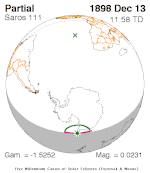 Partial |
116 | June 8, 1899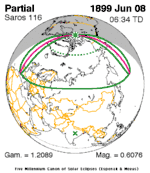 Partial | |
| 121 | December 3, 1899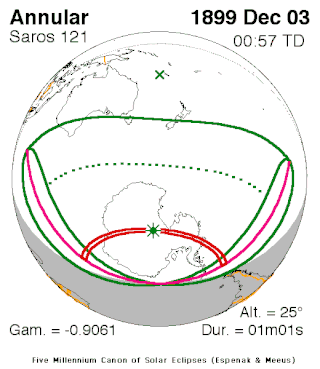 Annular |
126 | May 28, 1900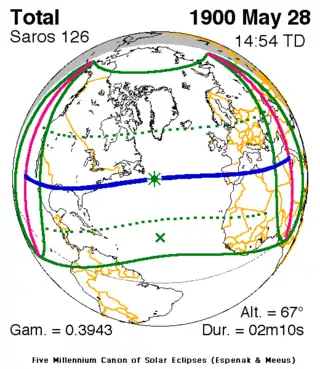 Total | |
| 131 | November 22, 1900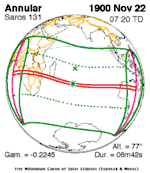 Annular |
136 | May 18, 1901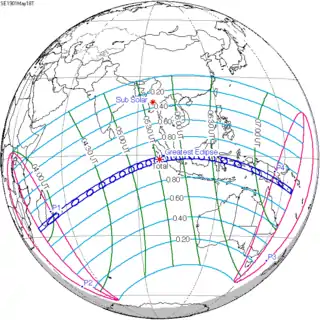 Total | |
| 141 | November 11, 1901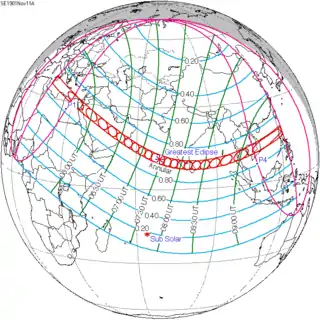 Annular |
146 | May 7, 1902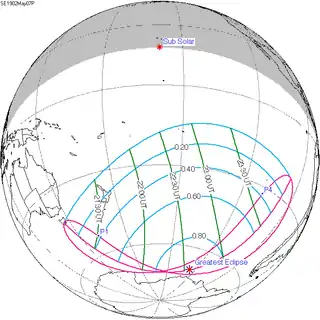 Partial | |
| 151 | October 31, 1902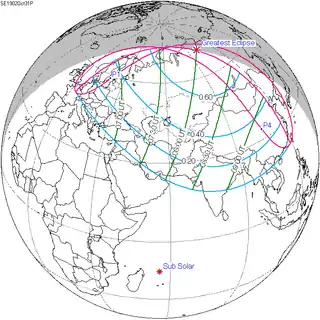 Partial | |||
Saros 131
It is a part of Saros cycle 131, repeating every 18 years, 11 days, containing 70 events. The series started with partial solar eclipse on August 1, 1125. It contains total eclipses from March 27, 1522 through May 30, 1612 and hybrid eclipses from June 10, 1630 through July 24, 1702, and annular eclipses from August 4, 1720 through June 18, 2243. The series ends at member 70 as a partial eclipse on September 2, 2369. The longest duration of totality was only 58 seconds on May 30, 1612. All eclipses in this series occurs at the Moon’s ascending node.
| Series members 33–70 occur between 1702 and 2369 | ||
|---|---|---|
| 33 | 34 | 35 |
 July 24, 1702 |
 August 4, 1720 |
 August 15, 1738 |
| 36 | 37 | 38 |
 August 25, 1756 |
 September 6, 1774 |
 September 16, 1792 |
| 39 | 40 | 41 |
 September 28, 1810 |
 October 9, 1828 |
 October 20, 1846 |
| 42 | 43 | 44 |
 October 30, 1864 |
 November 10, 1882 |
 November 22, 1900 |
| 45 | 46 | 47 |
 December 3, 1918 |
 December 13, 1936 |
 December 25, 1954 |
| 48 | 49 | 50 |
 January 4, 1973 |
 January 15, 1991 |
 January 26, 2009 |
| 51 | 52 | 53 |
 February 6, 2027 |
 February 16, 2045 |
 February 28, 2063 |
| 54 | 55 | 56 |
 March 10, 2081 |
 March 21, 2099 |
 April 2, 2117 |
| 57 | 58 | 59 |
 April 13, 2135 |
 April 23, 2153 |
 May 5, 2171 |
| 60 | 61 | 62 |
 May 15, 2189 |
 May 27, 2207 |
 June 6, 2225 |
| 63 | 64 | 65 |
 June 18, 2243 |
 June 28, 2261 |
 July 9, 2279 |
| 66 | 67 | 68 |
 July 20, 2297 |
 August 1, 2315 |
 August 11, 2333 |
| 69 | 70 | |
 August 22, 2351 |
 September 2, 2369 | |
See also
References
- ↑ "Saros Series 131". Catalog of Solar Eclipses. NASA. Retrieved 6 October 2018.
- 1 2 "AN ECLIPSE TO-DAY". Minneapolis Daily Times. Minneapolis, Minnesota. 1900-11-22. p. 5. Retrieved 2023-10-27 – via Newspapers.com.
- 1 2 3 4 5 "ECLIPSE OF THE SUN". South Australian Register. Adelaide, SA. 1900-11-22.
- ↑ "Page 4". Hopkinsville Kentuckian. Hopkinsville, Kentucky. 1900-11-20. p. 4. Retrieved 2023-10-31 – via Newspapers.com.
- ↑ "Forecast for November". The Missoula Democrat. Missoula, Montana. 1900-11-20. p. 2. Retrieved 2023-10-31 – via Newspapers.com.
- 1 2 3 "Eclipse of the sun". The Daily Telegraph. Sydney, New South Wales, Australia. 1900-11-22. p. 5. Retrieved 2023-10-27 – via Newspapers.com.
- ↑ "Eclipse of the Sun Tomorrow". The Plain Speaker. Hazleton, Pennsylvania. 1900-11-20. p. 4. Retrieved 2023-10-31 – via Newspapers.com.
- 1 2 "The Eclipse of the Sun". The Perthshire Advertiser, etc. Perth, Tayside, Scotland. 1900-11-21. p. 5. Retrieved 2023-10-27 – via Newspapers.com.
- ↑ "Page 4". The Macleay Chronicle. Kempsey, New South Wales, Australia. 1900-11-22. p. 4. Retrieved 2023-10-27 – via Newspapers.com.
- ↑ "Partial eclipse of the sun". The Age. Melbourne, Victoria, Victoria, Australia. 1900-11-23. p. 6. Retrieved 2023-10-27 – via Newspapers.com.
- ↑ "ECLIPSE OF THE SUN". Lithgow Mercury. Lithgow, New South Wales, Australia. 1900-11-23. p. 5. Retrieved 2023-10-27 – via Newspapers.com.
- ↑ "Brevities". The Evening News. Sydney, New South Wales, Australia. 1900-11-24. p. 4. Retrieved 2023-10-27 – via Newspapers.com.
- ↑ "Eclipse of the Sun". The Albany Advertiser. Western Australia. 1900-11-23. p. 3.
- ↑ "YESTERDAY'S ECLIPSE OF THE SUN. THE GOVERNMENT ASTRONOMER'S OBSERVATIONS". The West Australian. Perth, Western Australia. 1900-11-23. p. 5.
.jpg.webp)

